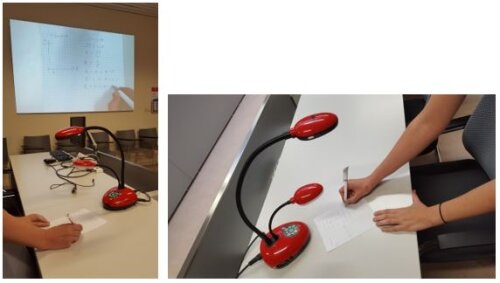in cooperation with Milou de Smet (Education Department, UAntwerp)
You may have seen one in your classroom before: a document camera (doccam). It looks like a red desk lamp with lots of coloured buttons, but nothing could be further from the truth! The compact doccams actually replace overhead projectors and offer many additional features. In short, the doccam films everything you put under it and projects it onto the white screen via the projector. So no more markers and transparencies!

In this tip, we give you inspiration and some examples of how to use the doccam in your lessons. We start by going over some of the advantages of working with the doccam:
- Students can continue to watch
A key advantage of the doccam is that you face the students, meaning you can keep looking at the group instead of having your back to them as you write (like with the board). This means more room for interaction; you can see your students' reactions better.
- Zooming in and increasing readability
In large leacture halls with many students, those on the back rows sometimes have trouble reading the board. A solution is to project with the doccam to make content readable. The doccam also allows you to zoom in on certain parts of your paper or object. You can also easily switch between your (PowerPoint) presentation and the doccam projection. You just set your presentation screen to 'white' (e.g. via the keyboard shortcut Ctrl w in PowerPoint) to go to the doccam.
- Increased readability in lesson recordings
Another advantage of working with the doccam is when you record your lesson through Mediasite. Typically, the classic board is included on the Mediasite video, but what’s on it isn’t sharp enough to read. So, anything you write on the board is likely to be impossible or difficult to read for students watching the videos afterwards. If you show the same content with the doccam, though, a legible board can be recorded for the video. An example of such a lesson recording using the doccam can be viewed here (after login for UAntwerp staff).
What can you actually do with the doccam? Here are some examples to get started:
- Revealing your reasoning step by step
Many teachers like working on a board during the lesson because it allows you to gradually build your reasoning, sharing it with the students. Think, for example, about building formulas, calculations or diagrams. Under doccam, you can easily work out these reasonings on paper, as you would on blackboard. Moreover, you can work under the doccam with the type of paper (blank, lined or squared) relevant for the content, i.e. certain diagrams or formulas.
- Showing objects and skills
You can actually put any object under the doccam and project it. So you no longer need to pass objects (e.g. books or technical material) through the room, but can instead display them via the doccam. Or, if you want to show a finer technique or action up close (e.g. in practicals) you can also do it this way.
- Getting students to collectively share their solutions
When students have to work out their own solution or come up with an idea during an activity, it can be difficult to share it afterwards with the group. With small groups, some teachers work with large flipchart sheets that are afterwards shown to the rest of the group or left on display. Sometimes readability can be an issue here, and with larger groups of students especially, this is often isn’t feasible. The doccam can help here. In other words, students or groups can write down their answers or ideas on an A4 and then show and explain them at the front under the doccam. The tutor can also correct (anonymous) student exercises under the doccam, giving feedback while doing so.
Want to know more?
In this video the New Media Office explains in less than a minute how to use the document camera (in Dutch).
In this excerpt from a lesson recording a teacher gets started with the doccam (in Dutch, for UAntwerp staff only, after login).
This (English) video explains the use of the doccam in a little more detail.
Lees deze tip in het Nederlands